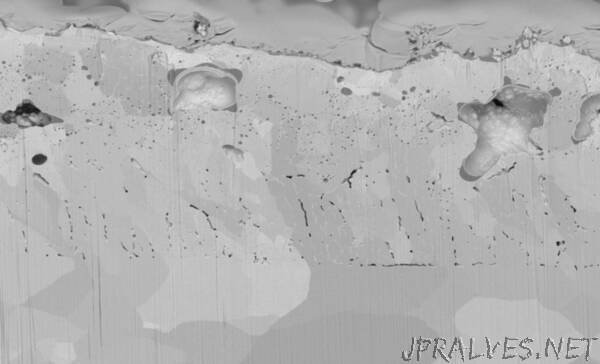
“In tokamaks, magnetic confinement devices being explored for use as nuclear fusion reactors, anomalous events can cause a transfer of energy with 10 million times the intensity of the solar radiation on Earth’s surface. These events can cause damage to structural components, potentially threatening the longevity of a tokamak.
Penn State researchers recently published a paper on simulating these conditions in the laboratory, without use of a tokamak, to investigate the effects of such an extreme heat load on tungsten. They published their findings in npj Materials Degradation on Oct. 2.
“To make fusion power really work instead of just working theoretically, we need to understand how some materials will survive better than others,” said Leigh Winfrey, associate professor in the Ken and Mary Alice Lindquist Department of Nuclear Engineering. “This research gives us a better understanding of the problem.”
When a tokamak operates, high-energy plasma flows through its chamber in a donut-like shape, bounded by magnetic fields so the plasma — often at temperatures of several hundred million degrees Fahrenheit — does not touch the tokamak walls. Devices called divertors are in contact with portions of the plasma to remove waste products. The divertors must be able to withstand the heat transfer from typical tokamak operations as well as unusual events created by plasma instability, analogous to the eruption of a solar flare on the sun’s surface. These anomalies can deliver extreme heat loads at durations from milliseconds to minutes.
The researchers investigated the effects of these anomalous events on tungsten, a metal being explored for use in tokamak fusion reactor divertors. Tungsten’s melting point is the highest of any pure element, and it has a high capacity for transferring heat away after absorbing it.
The experimental portion of the study took place at the University of Florida where Winfrey previously served as a faculty member. Tungsten was used as an inner lining for insulated tubes with an inner diameter of 4 mm, about the length of a sesame seed, and an outer diameter of 6.9 mm. Electrical charges were pulsed through the tube at intervals of one to two millionths of a second. The supply of current over a small area and short duration created plumes of arced plasma, which generated flows of energy called heat fluxes over the tube’s surface that measured up to 46.3 gigawatts per square meter. For comparison, more than 400 wind turbines are necessary to produce energy at a rate of one gigawatt.
The samples were tested at four different heat fluxes and analyzed with a scanning electron microscope after cooling completely. While the extent of damage differed between heat flux exposures, each one created three distinct layers in the tungsten cross section. The first layer consisted of fully melted tungsten that had resolidified, the second had been partially melted and non-damaged tungsten made up the third layer.
Microfeatures varied between layers. The first layer contained numerous features, including formations in rose-like shapes, small voids forming from shear and thermal stresses, copper nanoparticles transferred during the electrical pulsing and new growth of microscopic groups of crystals called grains. The second, partially melted layer exhibited a number of voids that were aligned toward the heat source and columnar grains that were less aligned toward the heat source. In the third layer, grains grew in size by attaching smaller grains, much like a raindrop sliding down a window will collide with other drops to form a larger one.
Because each of these microfeatures can be attributed to a specific cause, these details can give researchers insights into further research on designing materials with better survivability in a fusion environment, according to Winfrey.
“The features in these layers can be traced back to a physical process,” Winfrey said. “And when you know what physical mechanisms are causing these microfeatures, you can start to change the way the material is made to make it resistant to this damage.”
Minsuk Seo, doctoral student in nuclear engineering at Penn State, and John Echols, a past student of Winfrey’s at the University of Florida and currently a postdoctoral research associate at Oak Ridge National Laboratory, also contributed to this study. Funding support for the research was provided by the University of Florida and the Ken and Mary Alice Lindquist Department of Nuclear Engineering.”
